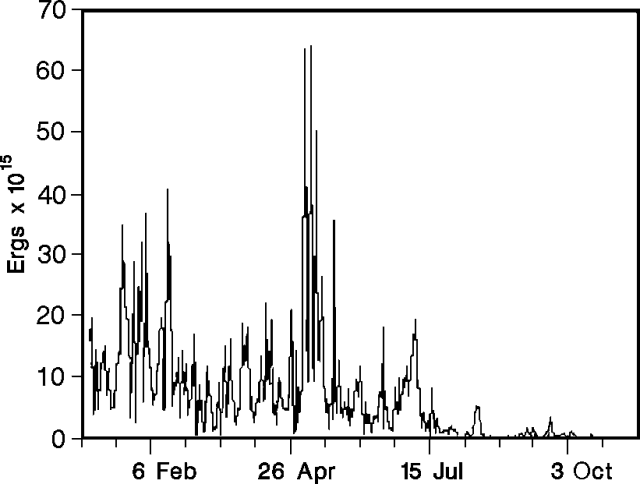Report on Galeras (Colombia) — October 1992
Bulletin of the Global Volcanism Network, vol. 17, no. 10 (October 1992)
Managing Editor: Lindsay McClelland.
Galeras (Colombia) Gas emission; seismicity declines; little deformation
Please cite this report as:
Global Volcanism Program, 1992. Report on Galeras (Colombia) (McClelland, L., ed.). Bulletin of the Global Volcanism Network, 17:10. Smithsonian Institution. https://doi.org/10.5479/si.GVP.BGVN199210-351080
Galeras
Colombia
1.22°N, 77.37°W; summit elev. 4276 m
All times are local (unless otherwise noted)
October surface activity . . . was characterized by gas emissions that produced white columns averaging 100 m high. These extended toward the N and W flanks. SO2 flux remained at low levels, ranging from 36 to 468 t/d.
Seismicity declined again in October, and was limited to small-magnitude events. High-frequency shocks were concentrated N and W of the active crater at depths of 1-6 km. Magnitudes were <2.3. Three low-energy swarms were recorded, on 1, 5, and 14 October. Long-period events were infrequent and of low energy (figure 61). The most vigorous long-period activity occurred on 15 October, when 12 earthquakes released roughly 1014 ergs of energy. The month's two episodes of harmonic tremor had dominant periods of 0.8 and 0.7 seconds and maximum amplitudes of 4 and 4.5 mm, respectively. Deep tremor was variable, with an average duration of 1.5 minutes and a maximum amplitude of 2 mm. Energy levels were generally low.
 |
Figure 61. Long-period seismic energy release at Galeras, January-October 1992. Courtesy of INGEOMINAS. |
Total tangential deformation at [Crater Station] was 5.98 µrad during October. After 9 October, several-day episodes of roughly SW-trending deformation alternated with periods of similar length and magnitude trending approximately NE, yielding little cumulative change.
Geological Summary. Galeras, a stratovolcano with a large breached caldera located immediately west of the city of Pasto, is one of Colombia's most frequently active volcanoes. The dominantly andesitic complex has been active for more than 1 million years, and two major caldera collapse eruptions took place during the late Pleistocene. Long-term extensive hydrothermal alteration has contributed to large-scale edifice collapse on at least three occasions, producing debris avalanches that swept to the west and left a large open caldera inside which the modern cone has been constructed. Major explosive eruptions since the mid-Holocene have produced widespread tephra deposits and pyroclastic flows that swept all but the southern flanks. A central cone slightly lower than the caldera rim has been the site of numerous small-to-moderate eruptions since the time of the Spanish conquistadors.
Information Contacts: F. Muñoz, INGEOMINAS—Observatorio Vulcanológico del Sur.

